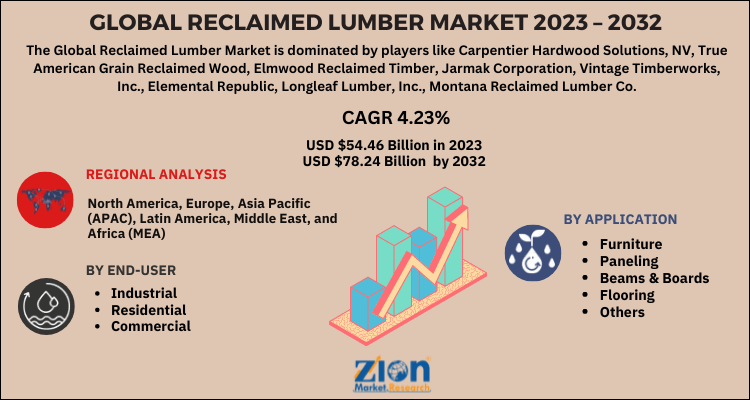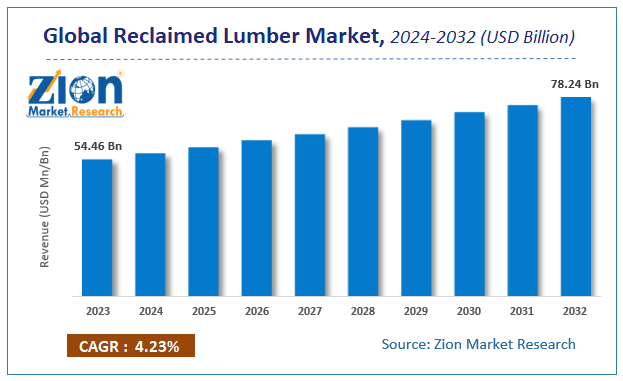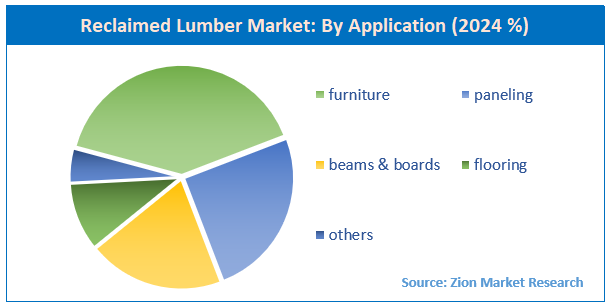Reclaimed Lumber Market Size, Share, Trends, Analysis To 2032

Reclaimed Lumber Market By Application (furniture, paneling, beams & boards, flooring, and others. ), By End-Use(industrial, residential, and commercial.) And By Region: - Global Industry Analysis, Size, Share, Growth, Trends, and Forecast, 2024-2032
| Market Size in 2023 | Market Forecast in 2032 | Growth Rate (in %) | Base Year |
|---|---|---|---|
| USD 54.46 Billion | USD 78.24 Billion | CAGR at 4.23% | 2023 |
Description
Reclaimed Lumber Market Insights
The value of the global market for reclaimed lumber was 54.46 billion dollars in 2023, and Zion Market Research projects that it will increase to 78.24 billion dollars by the end of 2032. The market is expected to grow with a CAGR of 4.23% during the forecast period.
This study provides an analysis of the growth drivers, growth restrictions, and influence on demand that are associated with the Global Reclaimed Lumber Market over the time of forecasting. Additionally, it will assist in navigating and investigating the possibilities that are becoming available in the Reclaimed Lumber Market market.
Key Insights:
- As per the analysis shared by our research analyst, the reclaimed lumber market is anticipated to grow at a CAGR of 4.23% during the forecast period (2024-2032).
- The global reclaimed lumber market was estimated to be worth approximately USD 54.46 billion in 2023 and is projected to reach a value of USD 78.24 billion by 2032.
- The growth of the reclaimed lumber market is being driven by increasing demand for sustainable, eco-friendly, and aesthetically unique building materials.
- Based on the application, the furniture segment is growing at a high rate and is projected to dominate the market.
- On the basis of end-use, the industrial segment is projected to swipe the largest market share.
- By region, North America is expected to dominate the global market during the forecast period.
Global Reclaimed Lumber Market: Overview
Reclaimed lumber is milled wood that is recovered from initial installation for reuse in new applications. It is upcycled, high-quality wood recovered from several sources, such as stock farms, old barns, warehouses, factories, retired ships, and many more. It is been widely used in businesses and homes for flooring, furniture, architectural details, cabinetry, etc.
Global Reclaimed Lumber Market: Growth Factors
The global reclaimed lumber market is gaining popularity and is surging at a lucrative rate. An increase in environmental awareness leading to the use of recycled material, a rise in the use of wood for decorating homes & businesses, and a rise in popularity of green building are the primary factors that are propelling the growth of the global reclaimed lumber market. The use of reclaimed lumber is an environmentally friendly approach. It leads to a decrease in the demand for newly sourced lumber, that helps curb deforestation. In addition to this, reclaimed wood has multiple uses, is harder than virgin wood as it usually comes from old trees, has unique look, and is with guilt-free. With all such benefits, the reclaimed lumber industry is rising with enormous momentum.
All these factors, as well as a decline in quality of new lumber, rise in concerns regarding environmental impact, and increase in waste disposal & deconstruction, are all contributing to the growth of the global reclaimed lumber market. Moreover, growing demand from the residential sector for interior design and furniture is also one of the factors spurring the growth of the global market. Furthermore, the growing demand for customized furniture and the rise in renovation & reconstruction of old buildings will provide multiple opportunities for the growth of the global reclaimed lumber market over the forecast period. However, the downside of reclaimed lumber, including high cost and legitimacy, may hamper the growth of the global reclaimed lumber market.
The outbreak of Covid-19 has severely affected the growth of the global reclaimed lumber market. The construction industry has shut down their ongoing sites and also postponed the launch of new sites due to restrictions on personnel movement and a complete lockdown across the cities. The scarcity of raw material due to disruption in the supply chain was also one of the concerns for the construction industry. Moreover, the pandemic has led to a change in consumer behavior, which has resulted in a decline in the demand for reclaimed lumber. Thus, the reclaimed lumber industry experienced a setback in its growth during the pandemic, thereby affecting the growth of the global market.
Global Reclaimed Lumber Market: Segmentation
The global reclaimed lumber market is bifurcated based on application, end-use, and region.
Based on Application, the global reclaimed lumber market is divided into furniture, paneling, beams & boards, flooring, and others. Among these, the furniture segment is estimated to account for the largest share in the market. This is attributed to the growing demand for furniture of unique style in the business and residential sectors.
Based on End-Use, the global market is split into industrial, residential, and commercial. Among these, the commercial segment is estimated to account for maximum share due to its growing demand from restaurants, resorts, and offices.
 Request Free Sample
Request Free Sample
Recent Development
- In December 2024, the World Architecture Festival honored two Indian projects. 'AGRITECTURE' by gRID Architects won in the Future Project: Experimental category. The project integrates sustainable urban living with agricultural elements, utilizing mild steel, polycarbonate sheets, and reclaimed wood to ensure optimal light penetration and structural integrity. Additionally, 'OH HO Residence' by Play Architecture secured an award, showcasing innovative design and material application.
- In October 2024, the Softwood Lumber Board, in collaboration with the USDA Forest Service, launched a USD 1.8 million competition to advance mass timber use in K-12 educational facilities. This initiative promotes sustainable construction and encourages the integration of reclaimed lumber in classrooms, libraries, and other learning spaces across the U.S.
- In February 2024, the Baltimore Wood Project launched an initiative to transform urban wood renewal by building a regional economy centered on wood and land restoration. The project salvages reclaimed lumber from vacant homes, diverting waste from landfills and preserving the city's history. Through an expanded model, the initiative delivers significant environmental impact and empowers the lives of its participants.
Reclaimed Lumber Market: Report Scope
| Report Attributes | Report Details |
|---|---|
| Report Name | Reclaimed Lumber Market Research Report |
| Market Size in 2023 | USD 54.46 Billion |
| Market Forecast in 2032 | USD 78.24 Billion |
| Growth Rate | CAGR of 4.23% |
| Number of Pages | 201 |
| Key Companies Covered | Carpentier Hardwood Solutions, NV, True American Grain Reclaimed Wood, Elmwood Reclaimed Timber, Jarmak Corporation, Vintage Timberworks, Inc., Elemental Republic, Longleaf Lumber, Inc., Montana Reclaimed Lumber Co., Atlantic Reclaimed Lumber, LLC, and TerraMai, among others. |
| Segments Covered | By Application, By End-Use, and By Region |
| Regions Covered | Latin America, North America, Asia Pacific, Europe, The Middle East, And Africa |
| Base Year | 2023 |
| Historical Year | 2018 to 2022 |
| Forecast Year | 2024 - 2032 |
| Customization Scope | Customized purchase options are available to meet your exact research needs. Request For Customization |
Reclaimed Lumber Market Dynamics
Key Growth Drivers
The reclaimed lumber market is experiencing robust growth driven by a global shift towards sustainable and eco-friendly practices in the construction and design industries. A growing consumer awareness of the environmental impact of new timber harvesting, such as deforestation, is fueling the demand for repurposed materials that reduce waste and promote a circular economy. Reclaimed lumber's unique aesthetic appeal, characterized by its patina, nail holes, and historical markings, is highly sought after by architects, designers, and homeowners for creating custom furniture, flooring, and decorative elements with a distinctive, rustic charm. Furthermore, government initiatives and green building certifications, like LEED, are increasingly encouraging the use of recycled materials, providing a strong regulatory push for market expansion.
Restraints
Despite the clear benefits, the reclaimed lumber market faces several significant restraints. One of the main challenges is the inconsistent supply and quality of the raw material. Unlike new lumber, which is consistently sourced from managed forests, reclaimed wood comes from a variety of sources like old barns, factories, and ships, leading to variability in species, dimensions, and condition. This makes it difficult for suppliers to guarantee a consistent supply for large-scale projects. The high cost of processing and de-nailing the wood, coupled with the specialized labor required, can also make reclaimed lumber more expensive than new timber, which is a major financial barrier for price-sensitive buyers. Additionally, there are potential safety hazards such as the presence of old nails, lead paint, and pests like termites, which necessitate a rigorous and costly treatment process.
Opportunities
The reclaimed lumber market is presented with significant opportunities for innovation and expansion. The integration of technology is a key growth avenue, with the development of AI-guided sorting systems and portable processing units that can improve efficiency, lower costs, and ensure consistent quality. The market is also expanding into new applications, such as the use of reclaimed lumber in high-end, custom-made furniture and in the production of Cross-Laminated Timber (CLT) for tall wooden buildings, which aligns with sustainable building practices. The growth of the e-commerce and direct-to-consumer (DTC) channels provides a new avenue for suppliers to reach a broader customer base and offer a wider range of products, bypassing traditional retail and supply chain complexities.
Challenges
The reclaimed lumber market faces a number of complex challenges. A major challenge is the intense competition from alternative building materials that are often cheaper, more readily available, and consistent in quality, such as new wood, composites, and synthetic materials that mimic the appearance of reclaimed wood. The industry must also contend with a fragmented supply chain and a lack of standardized regulations, which can complicate the process of sourcing, processing, and distributing the wood on a global scale. Additionally, the need for continuous education and marketing to raise consumer awareness about the product's value and address potential concerns about its quality and safety is an ongoing challenge.
Global Reclaimed Lumber Market: Regional Analysis
Based on the region, Europe is anticipated to lead the global reclaimed lumber market and is expected to maintain its dominance during the forecast period. Factors such as the rise in demand for green buildings, the presence of major players, and the growing demand for reclaimed lumber for interior design. North America is projected to contribute to a significant share in the market. Growing concerns of environmental impact, a decline in deforestation, and an increase in residential & commercial projects will also drive regional market growth. On the other hand, the market in Asia Pacific is expected to rise with the highest CAGR. This is attributed to an increase in the use of recycled material, growing necessity to curb deforestation, rise in disposable income, and most of the key players urging to expand their business in this region.
Global Reclaimed Lumber Market: Competitive Players
The major players operating in the global reclaimed lumber market are
- Carpentier Hardwood Solutions
- NV
- True American Grain Reclaimed Wood
- Elmwood Reclaimed Timber
- Jarmak Corporation
- Vintage Timberworks, Inc.
- Elemental Republic
- Longleaf Lumber, Inc.
- Montana Reclaimed Lumber Co.
- Atlantic Reclaimed Lumber, LLC
- TerraMai
- among others.
The Global Reclaimed Lumber Market is segmented as follows:
By Application
- Furniture
- Paneling
- Beams & boards
- Flooring
- Others.
By End-Use
- Industrial
- Residential
- Commercial.
Global Reclaimed Lumber Market: Regional Segment Analysis
- North America
- The U.S.
- Canada
- Europe
- France
- The UK
- Spain
- Germany
- Italy
- Rest of Europe
- Asia Pacific
- China
- Japan
- India
- South Korea
- Southeast Asia
- Rest of Asia Pacific
- Latin America
- Brazil
- Mexico
- Rest of Latin America
- Middle East & Africa
- GCC
- South Africa
- Rest of Middle East & Africa
What Reports Provide
- Full in-depth analysis of the parent market
- Important changes in market dynamics
- Segmentation details of the market
- Former, on-going, and projected market analysis in terms of volume and value
- Assessment of niche industry developments
- Market share analysis
- Key strategies of major players
- Emerging segments and regional markets
- Testimonies to companies in order to fortify their foothold in the market.
Table Of Content
FrequentlyAsked Questions
An increase in environmental awareness leading to the use of recycled material, rise in use of wood for decorating homes & business, and rise in popularity in green building are the primary factors that are propelling the growth of the global reclaimed lumber market. Furthermore, the growing demand for customized furniture and the rise in renovation & reconstruction of old buildings will provide multiple opportunities for the growth of the global reclaimed lumber market over the forecast period.
The major players operating in the global reclaimed lumber market are Carpentier Hardwood Solutions, NV, True American Grain Reclaimed Wood, Elmwood Reclaimed Timber, Jarmak Corporation, Vintage Timberworks, Inc., Elemental Republic, Longleaf Lumber, Inc., Montana Reclaimed Lumber Co., Atlantic Reclaimed Lumber, LLC, and TerraMai among others.
Based on the region, Europe is anticipated to lead the global reclaimed lumber market and is expected to maintain its dominance during the forecast period. Factors such as rise in demand for green building, presence of major players, and growing demand for reclaimed lumber for interior design.
Based on statistics from the Zion Market Research, the global Reclaimed Lumber Market size was projected at approximately US$ 54.46 Billion in 2023. Projections indicate that the market is expected to reach around US$ 78.24 Billion in revenue by 2032.
The global Reclaimed Lumber Market is expected to grow at a Compound Annual Growth Rate (CAGR) of around 4.23% during the forecast period from 2024 to 2032.
The global Reclaimed Lumber Market report provides a comprehensive analysis of market definitions, growth factors, opportunities, challenges, geographic trends, and competitive dynamics.
HappyClients
Zion Market Research
Tel: +1 (302) 444-0166
USA/Canada Toll Free No.+1 (855) 465-4651
3rd Floor,
Mrunal Paradise, Opp Maharaja Hotel,
Pimple Gurav, Pune 411061,
Maharashtra, India
Phone No +91 7768 006 007, +91 7768 006 008
US OFFICE NO +1 (302) 444-0166
US/CAN TOLL FREE +1 (855) 465-4651
Email: sales@zionmarketresearch.com
We have secured system to process your transaction.
Our support available to help you 24 hours a day, five days a week.
Monday - Friday: 9AM - 6PM
Saturday - Sunday: Closed






